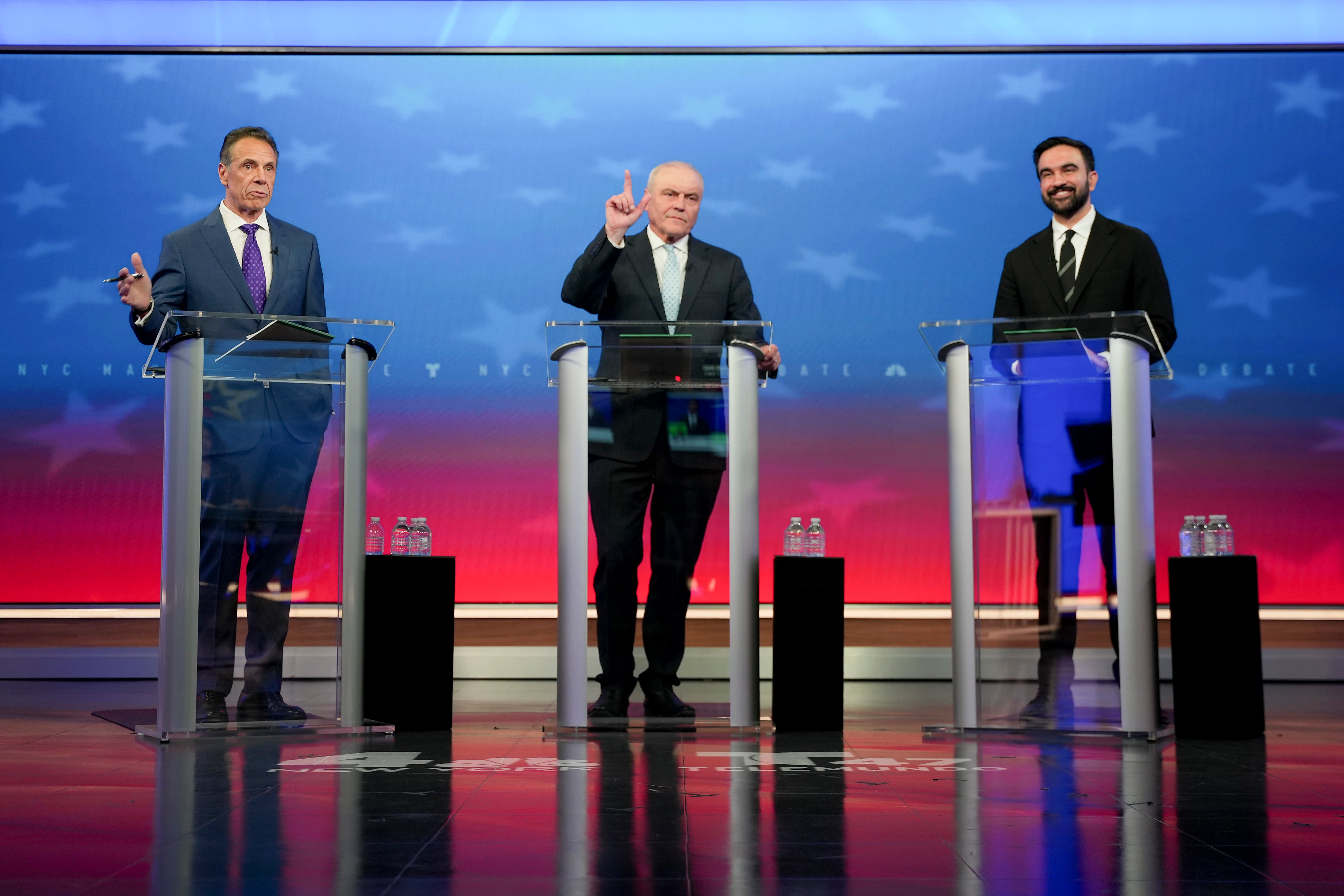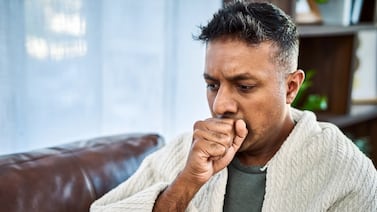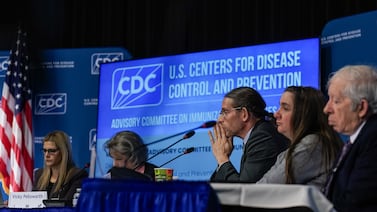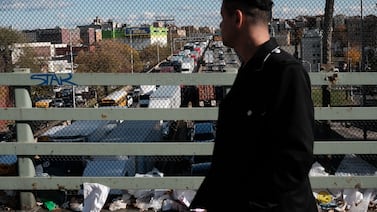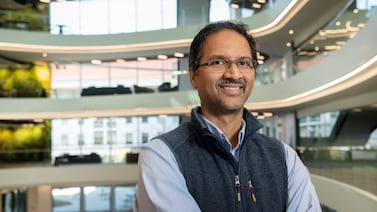Public health, explained: Sign up to receive Healthbeat’s free New York City newsletter here.
New York City’s next mayor will be forced to take on a range of public health challenges at a pivotal time for the city, from expected deep cuts to Medicaid and food assistance to a need to strengthen an aging, flood-prone infrastructure that wasn’t built to withstand the mounting effects of climate change.
Between age, political experience, and platforms, the Democratic candidates Zohran Mamdani and Andrew Cuomo couldn’t be more different. Mamdani is a 34-year-old state assemblyman who was born in Kampala, Uganda, and grew up in a comfortably middle-class household in Manhattan. He describes himself as a Democratic Socialist a la Bernie Sanders.
Cuomo is a 67-year-old former governor and Queens-born scion of a prominent family long at the helm of the state’s Democratic establishment. Mamdani’s victory in the June primary took New York by surprise as Cuomo conceded defeat and then withdrew to run as an independent.
Recent polls show Mamdani leading Cuomo, with Republican nominee and Guardian Angels founder Curtis Sliwa trailing behind. Mayor Eric Adams bowed out of the race, but his name will remain on the ballot. Election Day is Nov. 4; early voting begins Saturday and runs until Nov. 2.
A core part of the job at City Hall will be appointing a commissioner to lead one of the largest public health agencies in the world and to set priorities on issues like chronic disease, mental health, overdose prevention, vaccines, and climate and emergency preparedness.
As the nation’s oldest municipal public health agency, the New York City Department of Health and Mental Hygiene has an annual budget of $1.6 billion and more than 7,000 employees throughout the five boroughs. It is one of the world’s biggest public health agencies and will assume even greater responsibility at a time when the White House is dismantling federal agencies like the Department of Health and Human Services and the Centers for Disease Control and Prevention.
To this end, the new mayor will inherit the seemingly Herculean task of trying to work with — or resist — an administration that has shown little regard for New York. President Donald Trump’s “One Big Beautiful Bill Act” threatens to slash Medicaid and food assistance, and some 600,000 New Yorkers stand to lose their health insurance. Such changes are likely to take effect at the end of this year and are expected to have a severe impact on patients and providers.
“The stakes are enormously high,” said Diana Silver, professor of public health policy and management at the New York University School of Global Public Health.
These cuts will have a ripple effect. Possibilities include the elimination of coverage for certain health services, reduced rates paid to providers, and a spike in health care costs as providers take on uncompensated care and shift costs to state and city budgets.
Local hospitals that are already stretched thin will likely trim services or even close. The cottage industries that orbit hospitals and health systems in places like the Bronx are likely to suffer. According to a July study from the Fiscal Policy Institute, a nonpartisan independent think tank that studies New York state’s economy, the new legislation means the city could lose more than $5.4 billion in federal Medicaid funds, which could result in job losses of some 116,000.
“The safety-net hospital system is a place we have to watch very carefully,” Silver said.
The new mayor will also be expected to reduce high rates of drug overdoses and maternal mortality, especially among Black women.
The campaigns have said little about their health policies on their websites, social media feeds, and podcasts. Neither Mamdani nor Cuomo made their health policy advisers available for an interview with Healthbeat despite repeated requests. (Sliwa’s campaign website doesn’t list health matters among its platform issues).
People who care about public health in the city are wondering how the candidates will approach the challenges.
“The big question with each of [the candidates] is: What specifically are you going to do, and how are you going to find the resources to pay for all these things and take care of this,” said Bruce Y. Lee, professor of health policy and management at the City University of New York.
Candidates acknowledge need to address mental health
Mamdani says he wants to create a “corps of outreach workers” to help New Yorkers navigate the health care system. “Those workers will support patients in understanding the public resources available: How to find insurance, apply to programs, access financial assistance, and claim their health benefits.” These workers would also aim to help connect “every New Yorker in need of productive care to affordable, quality support.”
Though their plans as presented are short on detail, Mamdani and Cuomo have said they are keen on improving mental health in the city. Mamdani said he wants to create a Department of Community Safety, though he has acknowledged that some of the details are “still to be determined.” Modeled after a program in Eugene, Oregon, the agency would send mental health professionals — instead of police officers without training in the field of mental health — to respond to emergencies in which people are experiencing mental health crises.
Cuomo said he recognizes that health care is unaffordable in the city and created a proposal seeking to address New York’s “mental health crisis.” That means increasing housing for the “seriously mentally ill” by providing $2.6 billion in capital over five years to build at least 600 new units per year for adults with serious mental illness and/or substance use disorders who are homeless or at risk of homelessness.
Mayor will need to partner with governor to fix ‘massive holes’
Relations between New York and Albany have seldom been known for being harmonious. But because New York is likely to be a major target of Trump’s, it will be critical for the new mayor and governor to see eye to eye on policy issues. Shortfalls will abound; the two will need to figure out how to patch the budget.
“The mayor’s going to walk into having to deal with that and be a partner with the governor on how to fix those massive holes,” said Jason Cone, chief public policy officer for Robin Hood, a New York-based nonprofit that seeks to help New Yorkers escape poverty.
After a delay following his primary victory, Mamdani received an endorsement from Gov. Kathy Hochul, in September. It appeared in the opinion section of The New York Times, whose editorial board had rebuffed Mamdani with its non-endorsement of any mayoral candidate.
“I am confident that [Mamdani] has the courage, urgency, and optimism New York City needs to lead it through the challenges of this moment,” Hochul wrote, noting that Trump has cut Medicaid, food assistance, and federal funding for the city and threatened a federal takeover. “Mr. Mamdani and I will both be fearless in confronting the president’s extreme agenda — with urgency, conviction, and the defiance that defines New York.”
At a debate with Mamdani, Cuomo, and Sliwa on Thursday, the candidates were asked who was supporting Hochul’s re-election bid next year. No one raised their hand. After what must have been an awkward moment, Mamdani pointed out that Hochul had stood up to Trump.
A week before, at an Oct. 8 forum hosted by Crain’s New York Business that focused on economic issues, Cuomo was asked about his relationship with Albany. Would he need to mend fences before making “any major asks”?
“I don’t have to mend fences,” Cuomo answered. “I have a good relationship with the governor.”
How Mamdani, Cuomo would handle Trump
Cuomo has said he can work with Trump, and that their earlier encounters prove an asset. “I dealt with Mr. Trump as governor. We had very, very difficult times,” Cuomo said at a debate streamed live in June. “I got more help for New York from Trump than anyone expected. New York was one of the few places that he did not send in [National Guard] troops when he sent them everywhere else, because he didn’t want to deal with me. That’s the fact. I got him to send us masks.”
Mamdani has said repeatedly that he will stand up to Trump, who has tried to belittle the Democratic Socialist by calling him a “communist” and threatened to withhold billions of dollars in federal funding from New York City if he is elected.
Cuomo’s record as pandemic governor
Cuomo’s handling of the pandemic is certain to weigh on voters’ minds. Soon after the virus began circulating in New York, Cuomo received praise for his public presence as a calm and cool leader. Later, however, he faced criticism and a federal investigation for publicly undercounting the number of Covid-related nursing home deaths.
“Only 12 states had a lower rate of death than New York, which is incredible in my opinion since we had [Covid-19] first and worst,” Cuomo said at the June debate, adding that not enough credit is given “to the women and men in those nursing homes who worked so hard.”
Cuomo resigned from the governorship in 2021, after an attorney general report concluded that he had sexually harassed at least 11 women. His lieutenant governor, Hochul, took over. Cuomo denied wrongdoing and said the AG report was politically motivated.
Perhaps less known about Cuomo: Under Article 6 of the Public Health Law, local health agencies receive state reimbursement for essential public health services like communicable disease control and chronic disease prevention, and historically every municipality has been reimbursed at the same rate. In 2019, when Cuomo was governor, he cut the reimbursement rate for only New York City.
His administration justified the cut by saying the federal government contributed funding. That meant a loss of up to $90 million per year for the city’s health department, and work focusing on tuberculosis took a major hit.
Trenton Daniel is a freelance reporter in New York.

